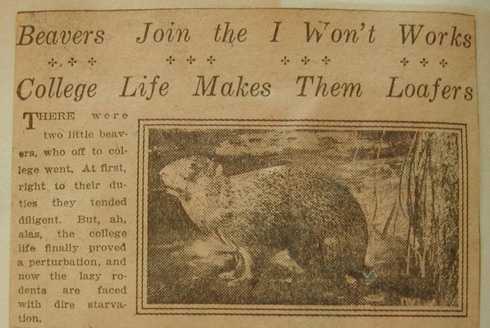In a letter to James Ford Bell dated September 19, 1917, in which he discussed preparations for mounted habitat groups to be installed at the Zoological Museum at the University, Dr. Thomas Sadler Roberts, Associate Curator, included a post script, “Have two live young beaver in an outside pool here at the U. Have much amusement watching them. They are making effort in part at house building! Wish you could see them.”

In a previous blog post, I shared the story of the two live beavers that were gifted to the Zoological Museum by the state game and fish commissioner, Carlos Avery, in 1917. The beavers lived in a pond outside of the Animal Biology Building (razed in 1994, at the current site of Hasselmo Hall), until their ultimate disappearance (Beaver 1, 1921), and passing (Beaver 2, 1924).
As I continued to research the presence of these beavers at the University, I found that Roberts’s amusement in these creatures, as he indicated to Bell, was such that he was compelled to publish a study of their curious behavior.
Roberts observed the beavers from his office window as they lounged away in their oblong-shaped pool (a concrete tank 40ft. long, 4 ft. wide, 4 ft. deep) next to the building. In a report titled, “How Two Captive Young Beavers Constructed a Food Pile,” given at the Minnesota Academy of Science in 1937, Roberts outlined his observations, “For the remainder of the warm weather these beavers frisked and played in the water, content to live in the box in which they arrived.”
Roberts was most curious as to how the beavers (then still babies – or kittens) would prepare for the winter months” despite the fact that they had “never had the advantage of parents to teach them how to conserve.” For their first winter, without the aid of modeling, the beavers began to construct a food-raft with twigs and branches to store their food so it could still be accessed when faced with frozen water. Curiously, as the beavers continued to occupy their campus pool, when time came to prepare for their second winter, they abandoned their initially exhibited seasonal behaviors.
Roberts’s four-page report outlined the construction of the beaver habitat, the food supply brought to them, and the vigorous behavior they displayed in preparing for their first winter, behaviors which, surmised Roberts, were common to their species. Yet within the constructs of the University environment, the beavers acted differently after a year in residence. Roberts indicated the reason in his report:
“And now, a curious thing happened the following fall. The pond did not freeze over when winter came because of a live steam pipe unknown to the beavers and the rest of us that ran along the basement wall the length of the tank, and so all the labor of building this food-raft went for naught. In fact, it was more trouble to get at the food supply… So the following fall, when the two loads of trees were furnished them in hope of seeing the process repeated, they took counsel with themselves and did not build a food raft. What was the use? They were living in a steam-heated apartment and why do to all the labor of preparing for ice which did not come?”
“Why they thus departed from their inborn plans may not be quite clear. Perhaps they had grown careless and slovenly but it looked surprisingly like drawing an inference and acting accordingly.”
Upon learning of this occurrence, the Minneapolis Journal poked fun at the beavers, and to an extent the student population of the University, in a February 19, 1919 article titled, “Beavers Join the I Won’t Works College Life Makes Them Loafers.” The article, which quoted Roberts and reported his observations of the beavers’ behavior, began with a snarky rhyme:
“There were two little beavers, who off to college went.
At first, right to their duties they tended diligent.
But, ah, alas, the college life finally proved a perturbation,
and now the lazy rodents are faced with dire starvation.”
